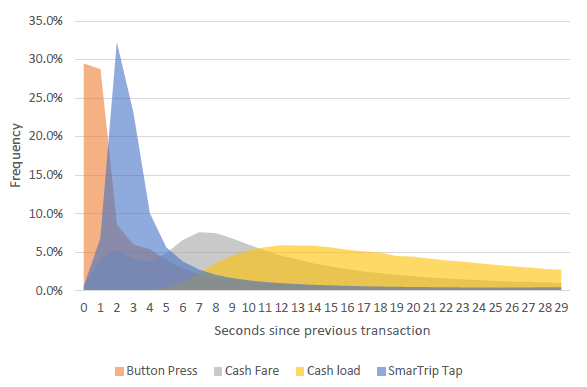
The inaugural Staten Island Bus Hackathon, hosted by TransitCenter
Open transit data makes using transit easy. It creates transparency and an informed public, facilitates citizen engagement, enables new research, helps transit agencies make better-informed decisions, and makes it possible for private companies to do free work for transit agencies. But don’t just take our word for it—hundreds of agencies have decided to share their transit schedule data publicly. Transitland, and Transit Feeds have made trip-planning apps like Google Maps, CityMapper, Transit App, and dozens of others possible, not to mention the type of comparative analysis presented on CNT’s AllTransit tool. Still, few transit agencies have adopted transit schedule data (“GTFS”) best practices, let alone managed to go beyond schedule data in their public reporting.
Why haven’t they? Because open data needs more internal champions. Two of the central barriers to the transit industry’s ability to adopt open data practices are a lack of understanding and a resistance to change among key agency staff.
What can open data do for your agency?
According to the Open Knowledge Foundation, open data are “data that can be freely used, shared and built-on by anyone, anywhere, for any purpose”. Open transit data are useful to enable trip routing, transparency, compare service between transit systems, and to improve operations for agencies themselves, especially when they make use of the same open data they publish.
These benefits of open data far outweigh the costs—though there are few real costs. Agency staff commonly cite a handful of risks and concerns: maintaining open data requires additional resources, those data could be misinterpreted by the public, data may not be 100 percent accurate, the data could be used to make the agency look bad, and in some cases privacy concerns. Privacy and staffing concerns can be legitimate as agencies should strive to ensure that up-to-date data are available for internal use and to open data consumers. Privacy concerns can be addressed, however, and, as the FTA has noted, agencies who have implemented open data policies often report net cost savings (and improved rider experience) after open data programs are in place. By and large, the private companies and data scientists who comprise open data’s primary user base also share transit agencies’ mission to improve transit service through careful analysis. And sometimes they build great projects like these useful data-based responses to the DC Metro’s recent disruptions.
WMATA bus dwell time caused by riders paying their fare

Time for a new fare payment system?
Bay Area Rapid Transit (BART) was the first transit agency to release its schedule data publicly in a digital format. After students expressed interest in BART’s schedule data, the agency recognized an opportunity to streamline internal operations and conserve agency resources when similar data requests came in the future. The agency staff who recognized this opportunity set a precedent and developed in-house expertise that has enabled BART to remain at the forefront of open data best practice, from GTFS adoption to real-time arrival information starting in 2008. The agency has continued its leadership, with BART’s board approving a new open data policy, developed in partnership with the Sunlight Foundation, in October 2016. As a result of its open data efforts, BART reports cost savings, the ability to reallocate staff, improved rider experience and perception of the agency, and increased private sector innovation.
What kind of data should agencies open? The more the merrier. To improve accountability, agencies would do well to focus on the data that are most influential in their work. Agencies can also prioritize by reviewing the data that are most commonly requested via freedom-of-information request, and by asking companies and citizen organizations what data would be most useful to them.
Here’s a few data types that TransitCenter deems particularly useful:
- Transit schedule (“GTFS”) data
- Real-time vehicle location (“AVL”) data
- Ridership data, reported at least at the route level
- Even better: modeled or measured passenger count (“APC”) data at the stop or station level
- Financial/budgetary data
- Performance statistics measured according to the agency’s performance goals and/or service standards
What can you do to open your agency’s data?
Generally speaking, agency analysts and mid-level staff increasingly understand the value of open data, often advocating for it internally. Barriers to increased adoption often come instead from senior managers who carry longstanding expectations about how their data should be managed.
This presents an important opportunity for higher-level transit agency staff and board members to make a big difference in the agencies they oversee. Rather than waiting for those senior managers to become senior leadership and someday retire, educate your colleagues and today’s senior leadership about the importance of open data, and work toward releasing new datasets, then setting policy to increase openness over time. Stress that the return on open data investment is substantial, especially when your agency is or would like to be maintaining those data internally, regardless.
TransitCenter has observed a bunker mentality amongst some transit agency staff and an abiding concern that the public is out to get them. We find, however, that the public simply wants better transit service.
To that end, transit agency staff and board members, please help your agency open its data (and its source code, where possible), and service improvements will follow. The industry at large will also be stronger as open data and open source tools become shared resources that agencies and their consultants build out together. And most importantly: riders will thank you for it.
More resources:
- Open Data: Challenges and Opportunities for Transit Agencies
- Open Data Handbook
- Open Data Guide: Transit
- Sunlight Foundation
 On the Brink: Will WMATA’s Progress Be Erased by 2024?
On the Brink: Will WMATA’s Progress Be Erased by 2024?
The experience of being a WMATA rider has substantially improved over the last 18 months, thanks to changes the agency has made like adding off-peak service and simplifying fares. Things are about to get even better with the launch of all-door boarding later this fall, overnight bus service on some lines starting in December, and an ambitious plan to redesign the Metrobus network. But all of this could go away by July 1, 2024.
Read More A Bus Agenda for New York City Mayor Eric Adams
A Bus Agenda for New York City Mayor Eric Adams
To create the “state-of-the-art bus transit system” of his campaign platform, Mayor Adams will have to both expand the quantity and improve the quality of bus lanes. We recommend these strategies to get it done.
Read More